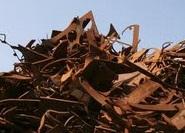Scrap Prices North America

Obsolete Scrap Flows Down 30%, June Prices Rise $20-$30
Written by John Packard
June 7, 2015
Ferrous scrap prices rose in June as obsolete flows continue to be weaker than normal and the domestic mills have come back into the market. The strength of the market has come as a surprise to dealers and mills alike.
Number 1 Heavy Melt (HMS) ranged from $230 to $265 per gross ton with the Midwest market settling at $250 per gross ton.
![]() Shredded scrap broke through the $300 barrier in the Southeast markets where the range was $295-$300. In the Midwest we saw prices slightly lower at $280-$285 per gross ton.
Shredded scrap broke through the $300 barrier in the Southeast markets where the range was $295-$300. In the Midwest we saw prices slightly lower at $280-$285 per gross ton.
#1 Busheling scrap ranged from $265to $300 per gross ton with the biggest numbers being seen in the Southeast. There has been pressure on busheling prices due to excessive supply from automotive plants and manufacturing plants which continue to run at peak capacity. We are pegging Midwest scrap at $265-$275 with an average of $270 per gross ton.
We heard from one of our east coast scrap sources over the weekend who explained how the negotiations progressed for those selling scrap into the domestic markets:
“The June ferrous market ended up much like the May market did – with the later sales being stronger than the earlier ones. And the consensus among people I talked with toward the end of the week was that the July market starts where June left off, despite being about a month away from the next trading session.
“The strength surprised many traders, but especially the mills themselves. It is hard to believe that five months into a new trading range obsolete scrap flows are still 30% below flows a year ago. But that is indeed the case I can tell you from personal experience. And the only way I can explain it is that is how it has always been, which is to say that obsolete flows follow price changes up and down. Add to that we have spent the last 10 years recycling a lot more scrap steel than we had in the prior decade and you have a situation where obsolete scrap is hard to come by. It’s actually been like this for several years but the significant and sudden price decline this past winter is making what has been a problem now a big problem.
“Where we go from here I think is a bit easier to anticipate than it’s been over the last few months. Finished prices have a ceiling of sorts because of the threat of imports and cheap pig iron. And metal margins at mills are pretty tight today, so they can’t just agree to higher and higher scrap prices without seriously considering alternatives. Plus, export demand will wane at some point as billet prices remain level and scrap gets less attractive. The trade cases are a bit of a wild card but until they are expanded to more products and we get more details about them I won’t dwell too much on their impact.
“So I think we are near a top (not there quite) in scrap prices for now (at least until the late fall this year) but it actually may turn out to be a new, higher, stable trading range so long as he operating rate stays around where it is and iron ore prices don’t change much.”

John Packard
Read more from John PackardLatest in Scrap Prices North America

HRC vs. scrap spread widens over $150/ton in March
The HRC vs. prime scrap spread increased again in March.

HRC vs. prime scrap spread increases in February
The price spread between hot-rolled coil (HRC) and prime scrap widened in February ahead of the implementation of President Trump’s tariffs on steel.
HRC vs. prime scrap spread narrows again in January
The price spread between hot-rolled coil (HRC) and prime scrap continued to narrow in January, according to SMU’s most recent pricing data. While SMU’s average HRC price edged down week over week (w/w), it rose compared to a month ago. The January price for busheling also increased from December. Our average HRC price as of […]

HRC vs. prime scrap spread flat in November
The price spread between hot-rolled coil (HRC) and prime scrap remained the same in November as both tags were at the levels seen a month earlier, according to SMU’s most recent pricing data.

HRC vs. busheling spread narrows slightly in October
The price spread between hot-rolled coil (HRC) and prime scrap narrowed marginally in October, according to SMU’s most recent pricing data.
